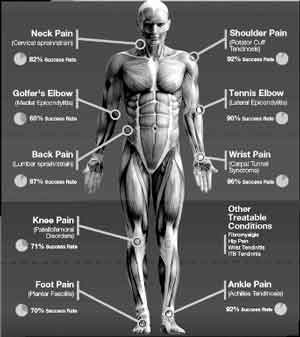by Dr Naisar Nahar
Soft tissues are the tissues that connect, support, or surround other structures and organs of the body, not being bone. It includes tendons, ligaments, fascia, fibrous tissues, fat (which are connective tissue) and muscles and blood vessels (which are not connective tissue). Soft tissue is a broad term that covers various groups of cells within the body. Each of these cell groups, or tissue, serves a purpose related to the body parts they are connected to e.g tendons, simply serve as connective tissue in order to join body structures, while other tissues, like muscles, might help foster movement. Composition- The characteristic substances inside the extracellular matrix of this kind of tissue are the collagen, elastin and ground substance. Normally the soft tissue is very hydrated because of the ground substance. The fibroblasts are the most common cell responsible for the production of soft tissues’ fibers and ground substance. Variations of fibroblasts, like chondroblasts, may also produce these substances. Some of the soft-tissue injuries you are most likely to experience include:
- Sprains
- Strains
- Contusions
- Tendonitis
- Bursitis
- Tennis elbow
- Golfer’s elbow
- Fibromyalgia
- Frozen shoulder
- fascitis
Any of these can be the result of a single episode, such as a fall, a sudden twist, or a blow to the body. You might also sustain one or more of these injuries because of repeated overuse, such as in ongoing athletic activities. In this case, small amounts of body stress accumulate slowly but steadily. The result can be damage and pain.
Here are some of the injuries you are most likely to experience, along with suggested ways of treating them.
Sprains – The joints of your body are supported by ligaments. Ligaments are strong bands of connective tissue that connect one bone to another. A sprain is a simple stretch or tear of the ligaments. The areas of your body that are most vulnerable to sprains are your ankles, knees, and wrists. Most mild sprains heal with “R.I.C.E.” (rest, ice, compression, and elevation) and exercise. Moderate sprains may also require a period of bracing. The most severe sprains may require surgery to repair torn ligaments.

Strains – Your bones are supported by a combination of muscles and tendons. Tendons connect muscles to bones. A strain is the result of an injury to either a muscle or a tendon, usually in your foot or leg. The strain may be a simple stretch in your muscle or tendon, or it may be a partial or complete tear in the muscle-and-tendon combination. The recommended treatment for a strain is the same as for a sprain: rest, ice, compression, and elevation. This should be followed by simple exercises to relieve pain and restore mobility. For a serious tear, the soft tissues may need to be repaired surgically.
Contusions – A contusion is a bruise caused by a blow to your muscle, tendon, or ligament. The bruise is caused when blood pools around the injury and discolors the skin. Most contusions are mild and respond well when you rest, apply ice and compression, and elevate the injured area. If symptoms persist, medical care should be sought to prevent permanent damage to the soft tissues.
Tendonitis – Inflammation is a healing response to injury. It is usually accompanied by swelling, heat, redness, and pain. An inflammation in a tendon or in the covering of the tendon is called tendonitis. Tendonitis is caused by a series of small stresses that repeatedly aggravate the tendon. Professional baseball players, swimmers, tennis players, and golfers are susceptible to tendonitis in their shoulders and arms. Soccer and basketball players, runners, and aerobic dancers are prone to tendon inflammation in their legs and feet. Tendonitis may be treated by rest to eliminate stress, anti-inflammatory medication, steroid injections, splinting, and exercises to correct muscle imbalance and improve flexibility. Persistent inflammation may cause damage to the tendon, which may necessitate surgical correction.
Bursitis – A bursa is a sac filled with fluid that is located between a bone and a tendon or muscle. A bursa allows the tendon to slide smoothly over the bone. Repeated small stresses and overuse can cause the bursa in the shoulder, elbow, hip, knee, or ankle to swell. This swelling and irritation is called bursitis. Many people experience bursitis in association with tendonitis. Bursitis can usually be relieved by rest and possibly with anti-inflammatory medication. Treating Doctor also inject the bursa with additional medication to reduce the inflammation
Tennis elbow – Tennis elbow, or lateral epicondylitis, is a painful condition that affects the outside or lateral side of the elbow. About half of all tennis players will experience this condition at some point in their lives, but general populations also suffer from it, as the condition can be brought on by many other activities. Treatment include to identify the original cause of his or her pain & rest & pain killer medicine.
Golfer’s elbow – Golfer’s elbow or medial epicondylitis is brought about by the same types of activities, but the pain is primarily felt on the inside of the elbow rather than the outside.
Fibromyalgia – Fibromyalgia is characterised by chronic widespread pain & a heightened and painful response to pressure. Other symptoms include debilitating fatigue, sleep disturbance and joint stiffness. Some people also report bowel & bladder abnormalities, numbness and tingling and cognitive dysfunction. Stress may be an important precipitating factor. It is frequently associated with psychiatric conditions such as depression and anxiety and stress-related disorders such as posttraumatic stress disorder. Not all people with fibromyalgia experience all associated symptoms. The cause of fibromyalgia is unknown. There is no universally accepted treatment or cure for fibromyalgia, and treatment typically consists of symptom management. Integrated treatment plans that incorporate medication, patient education, aerobic exercise and cognitive-behavioural therapy have been shown to be effective in alleviating pain and other fibromyalgia-related symptoms.
Frozen shoulder – Frozen shoulder, also called adhesive capsulitis, causes pain and stiffness in the shoulder. Over time, the shoulder becomes very hard to move. The hallmark sign of this condition is being unable to move your shoulder – either on your own or with the help of someone else. Causes include Diabetes, hypothyroidism, hyperthyroidism, Parkinson’s disease, cardiac disease and immobilization. Frozen shoulder generally gets better over time, although it may take up to 3 years & treatment include Physiotherapy, pain killer, steroids injection & if symptoms does not improve then surgery should be opted.
Fasciitis – Fascia is a specialized system of the body that has an appearance similar to a spider’s web or a sweater. Fascia is very densely woven, covering and interpenetrating every muscle, bone, nerve, artery and vein, as well as, all of our internal organs including the heart, lungs, brain and spinal cord. The most interesting aspect of the fascial system is that it is not just a system of separate coverings. It is actually one continuous structure that exists from head to toe without interruption. In this way you can begin to see that each part of the entire body is connected to every other part by the fascia, like the yarn in a sweater.Fasciitis refers to an inflammation of the fascia. In particular, it often refers to following diseases.- Plantar fasciitis
- Eosinophilic fasciitis
- Necrotizing fasciitis
- Paraneoplastic fascitis
